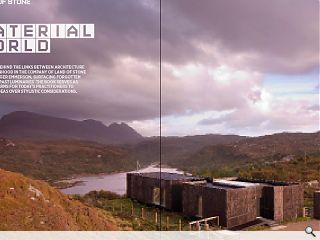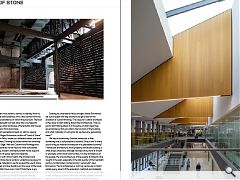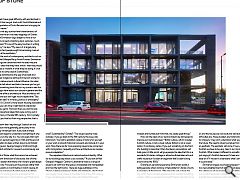Land of Stone: Material World
25 Apr 2023
We delve behind the links between architecture and nationhood in the company of Land of Stone author Roger Emmerson. Surfacing forgotten texts and past luminaries the book serves as a call to arms for today’s practitioners to embrace ideas over stylistic considerations.
Scotland, more than most nations, derives its identity from its landscapes and the distinctiveness of its cities comes from the beds of granite and sandstone on which they are built. The fault lines and schisms beneath our feet have their counterparts above and a unique urban landscape of tenements and houses has developed, hewn from local stone. Addressing such perceptions head-on with an openly sardonic headline Roger Emmerson, author of “Land of Stone” published by Luath Press, shows us a different nation, one built on the power of ideas.
Dividing his broad theme into three key areas: the Atlantic Edge, Wall and Column and Montage and Joint; Emmerson believes he has found a more considered means of assessing modern architecture that moves beyond well-worn concepts of space, light and materials. In conversation with Urban Realm, the architect said: “Calling it Land of Stone had a sardonic undertone because I’m well aware that the materials in use far exceed the use of stone, that’s why we’ve got a timber building on the cover of the book. One of the things that drove me is I don’t think there is any consistent theoretical basis in ideas for Scottish architecture. They are potentially there but we tend to ignore them by adopting ideas from elsewhere, not what we might derive from our own culture.” Seeking to understand these concepts better Emmerson set out to speak with key architects to get a feel for the evolution of current thinking. “The issue for Scottish architects is they have to start talking about their architecture.
They’ve got to start talking about it in the sense of what ideas they are embodying. Not just what is the function of the building and what materials is it using but do we have any generating ideas?” We had a distinctively Scottish vernacular, is that something that is still possible to achieve? Should we? Is there such a thing as national architecture in a globalised economy? “Vernacular architecture, more properly vernacular building, is what arises untutored, although handed on by word of mouth or example, within local communities. It is the architecture of the people, the only architecture of the people. Architects have sought in the past, especially in the last quarter of the twentieth century, to fabricate a ‘contemporary’ vernacular”, says Emmerson.
“Such architecture is not truly vernacular in that it entails every aspect of the education, methods and materials of contemporary architectural culture. It aspires to a vernacular in that it employs shared forms and a limited palette of lo-tech although still mass-produced materials. It is an illusion and I reject it. It’s about ideas. I’ve nothing against the idea of vernacular but what I have great difficulty with and lambast in the book is the fact that we got stuck with Scotch Baronial and Mackintosh’s interpretation of Scots Baronial and a longing for something of that nature.”
Railing against the lazy surface-level characteristics of Scottish Baronial and the art nouveau trappings of Charles Rennie Mackintosh Emmerson digs deeper to mine a rich seam of talent and concepts stretching back centuries, much of it largely untapped. “It’s one of the easy touches in writing architectural history”, he says. “My view is it is largely lazy scholarship when in fact people ought to be looking more at the ideas and less at the aesthetics.” Championing the work of contemporary architects such as Richard Murphy, Neil Gillespie Mary Arnold Forster, Emmerson notes: “The buildings are concerned with the sites they are located in and the ideas that they have, which I wish they would express but the idea is inherent in what they are doing. It’s not about harking back to some idea of Scottishness.” Rather than be distracted by the gee whizz bells and whistles of the latest magazine darlings Emmerson wishes to spark a deeper narrative around cultural influence.
He notes: “Inevitably I have to talk about aesthetics because you’ve got to describe what something looks like but my concern was the ideas which we might have about our culture in general and the specifics of how that affects architecture. Most architects will write on their website but won’t get much beyond that.” But what is meant by an idea? Is it theory, politics or philosophy? “I’d looked at Elder & Cannon’s more recent housing association work in Glasgow, you can drive it right back to Alexander Thomson. Once you get to Thomson then you start to look at some of the philosophical ideas that were coming out in Scotland and Germany in the late 18th century. Tom Connelly is not going to tell you that but from my perspective, that is something I see.
“Those ideas work their way through Scottish art and are inherent in culture more generally, particularly in the ideas generated by Immanuel Kant. If you look at these original texts you can begin to understand something of why Scottish architecture is the way it is. You can apply that right through the modern period beginning in 1745 and the end of the Jacobean rebellion to ideas written down by Archibald Allison, James Ferguson, George Gregory Smith and Hugh MacDiarmid. Scottish architects, I suspect unconsciously, are absorbing it.” In writing Land of Stone what Emmerson has achieved is to open up a fourth dimension of discourse, that of time. Demonstrating to readers that there is far more to great design than the here and now. Focussing on the process rather than the destination he paints a vivid timeline in which we are all furiously writing the next page of a story begun by others. Is today’s push for social good the equivalent of the reforming zeal of reformers in the Victorian age? Might Land of Tenements be a follow-up tome? What is today’s equivalent crisis? Sustainability? Climate?
“The issues become more complex. If you go back to the 19th century the issue was historicism. You had to establish a place in history for yourself or your work or absorb historical concepts and include it in your work. Now there are far more pressing issues to be concerned with; immigration, inequality and how architecture can resolve resource depletion.”
You equate architecture to nationhood and identity. What do our buildings say about us as a society? “If you look at Neil Gillespie’s Maggie’s Centre in Lanarkshire there is a range of issues to do with how the space is modulated and manipulated and how the light works. There are huge subtleties in this. There’s a dialogue between clients and architects, which I think was largely missing towards the latter third of the 20th century. It says something about the nature of Scotland that we’re not over the top; we don’t make a lot of noise. We are subtle, modest and humble but from that, we create great things.”
How can the ideas of our best architects be harnessed to improve our built landscape? “British culture, which includes Scottish culture, is not a visual culture. Britain is not a visual nation. It is a literary nation. If you put something on the front of a building to describe it then the literary associations will hold good. A little porch will give people the idea that this is a wonderful Victorian cottage or attractive Edwardian arts and crafts house but it’s been an argument that’s been kicking around since the 1920s.” Drawing on personal experience Emmerson recalls a telling episode when working in Newcastle for Charles Church, a subsidiary of Persimmon.
“We had a site just outside the city, which had an English appearance but wanted something modern. After we got approval the MD tried to rescind it so he could build double-fronted classical houses instead. We hung on and the houses are now built and sold but I can see what the difficulties are. House builders are historicists, They look back for imagery. They can’t understand what you have now or in the future. We need to divest ourselves from trying to replicate an aesthetic. The aesthetic will come. If we want to say that it’s Scottish we have to be very clear in our minds about why it is Scottish. What makes it different to something else or are we just saying it’s Scottish because it’s here and we want to slap a label on it? If we don’t understand what’s behind the label then it is just a label.” Emmerson argues we should progress from the stone age to a new enlightenment of ideas-based design distinct from the catalogues of visual elements that distract by looking back to a romanticised past. Instead, he points the way toward a brighter future shaped by information rather than physical characteristics.
|
|





